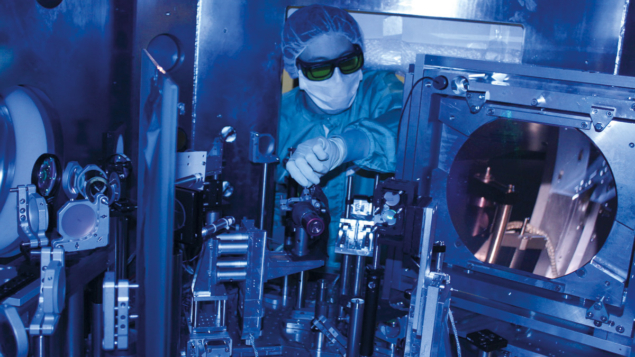
Spin-polarised particle beams are commonly used in particle and nuclear physics to test the Standard Model or to map out hadronic resonances. Until now, their production has relied on conventional radio-frequency-based accelerators. Laser–plasma interactions and beam-driven plasma acceleration have been shown to be feasible methods for obtaining high-energy particle beams over much shorter distances. Despite much progress in understanding the underlying phenomena of plasma-based acceleration, however, its ability to produce polarised beams has remained unproven.
Ten years ago, a group from Forschungszentrum Jülich and Heinrich-Heine University Düsseldorf in Germany proposed a concept for producing highly polarised electron, proton or ion beams through plasma acceleration based on the use of polarised targets. Here the spins of the particles to be accelerated are already aligned before plasma formation. Although the method seems simple in principle, it requires careful consideration of various technical challenges associated with maintaining and utilising polarisation in a plasma environment. After all, spin alignments typically require low temperatures, making it counter-intuitive that they could endure in a 108 K plasma for long enough to have practical applications.
A 2020 theoretical study of the scaling laws for the depolarisation times revealed the feasibility of polarised particle acceleration in strong plasma fields. Dozens of numerical simulations led to the conclusion that polarised beams from plasma acceleration should be within reach, with hadron beams requiring the simplest implementation. This is because hadrons have much smaller magnetic moments and, therefore, their spin alignment in the plasma magnetic fields is much more inert compared to electrons. Also, from the target point-of-view, polarised nuclei can be provided more easily than electrons.
In an experiment at the PHELIX petawatt laser at GSI Darmstadt, the Jülich–Düsseldorf group has now provided the first evidence for an almost complete persistence of nuclear polarisation after plasma acceleration to MeV energies. The group used an up-to 50% polarised 3He gas-jet target, which was irradiated by 2.2 ps laser pulses each with an energy of about 50 J. The polarisation of the accelerated 3He ions was measured with two identical polarimeters, optimised for short ion bunches from plasma acceleration and mounted perpendicular to the laser axis. For those cases where the nuclear spins in the target gas were aligned perpendicular to the flight direction of the helium ions, an angular asymmetry of the scattered particles in the polarimeters was observed, which is in line with a transversal polarisation of the accelerated 3He ions. No such asymmetries were found for the unpolarised gas.
The team now plans to repeat the experiments at PHELIX with higher gas polarisation and the use of a shorter (0.5 mm instead of 1.0 mm) gas-jet target. This would have the advantage that the 3He ions are dominantly emitted in the direction of the laser beam and at significantly higher energies (10–15 MeV). “For even higher laser intensities (> 10 PW), we have proposed a scheme based on shock acceleration to produce > 100 MeV polarised 3He beams,” says Markus Büscher of Jülich. “Also, a polarised hydrogen-chloride gas target for laser- or beam-driven acceleration of polarised proton and electron beams is being developed.”







